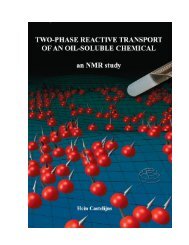P - Technische Universiteit Eindhoven
P - Technische Universiteit Eindhoven
P - Technische Universiteit Eindhoven
Create successful ePaper yourself
Turn your PDF publications into a flip-book with our unique Google optimized e-Paper software.
1. Introduction 13<br />
1 2<br />
initial mass<br />
relative mass<br />
3 4<br />
Disintegration<br />
5 6<br />
cycles<br />
Fig. 1.3: Results of a DIN 52 111 weathering test on a fired-clay brick. In the left graph,<br />
the relative mass of the samples is given as a function of the number of cycles. The<br />
corresponding pictures of one of the samples after each cycle are given at the right.<br />
After the 6th cycle the brick sample of 5x5x5 cm has completely disintegrated.<br />
1.4 Crystallization pressure<br />
Salt weathering is caused by the crystallization of salts within the pores of a material. A<br />
model of crystallization pressure, based on the idea of supersaturation of a salt solution,<br />
was proposed by Correns in 1945 [41]. In this model a salt solution that is supersaturated<br />
with respect to a growing crystal, is proposed as the driving force for crystallization<br />
pressure, as schematically presented in figure 1.4. Hence, the Correns model represents<br />
the crystallization pressure P c as a function of the supersaturation:<br />
P c = NRT<br />
V m<br />
ln<br />
( c<br />
c s<br />
)<br />
, (1.1)<br />
here R is the gas constant, T is the temperature, N is the number of ions in a salt molecule,<br />
V m is the molar volume of the crystalline phase, c/c s is the ratio between the actual and<br />
the saturation concentration of the salt solution. When a hydrated crystalline phase is<br />
formed, i.e., together with salt nuclei also water molecules are incorporated in a crystal,<br />
the effect of hydration has to be taken into account. The incorporation of water molecules<br />
from a solution into a hydrated crystal yields an increase of the actual concentration of<br />
the solution, leading to higher crystallization pressures. Taking into account the effect of<br />
hydration, the extended Correns model can be written in the form [42]:<br />
P c = RT<br />
V m<br />
ln<br />
[ ( c<br />
c s<br />
) N<br />
( 1 − (N − 1)c<br />
1 − (N − 1)c s<br />
(1 + cM H2 O)<br />
(1 + c s M H2 O)<br />
) ν ]<br />
, (1.2)
















